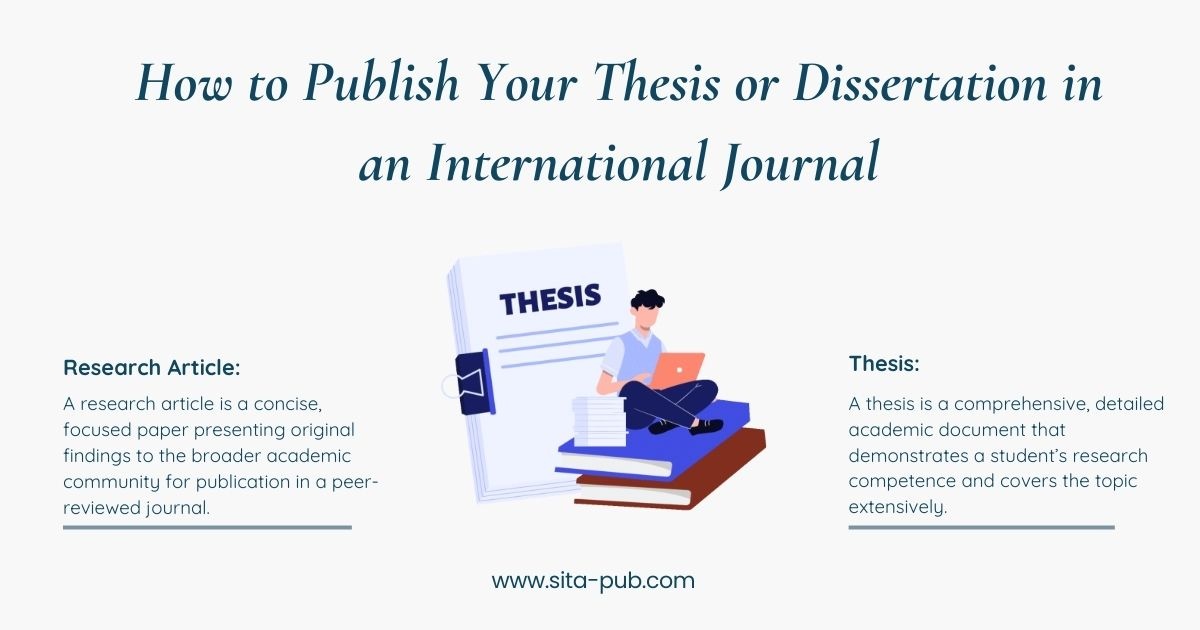Have you finished your thesis and wonder how to share your hard work with the world? Publishing your thesis in a journal can boost your career, build your reputation, and open doors to new opportunities.
But the process can feel confusing and overwhelming. Don’t worry—this guide will walk you through each step clearly and simply. By the end, you’ll know exactly how to turn your thesis into a published article that stands out. Keep reading to make your research shine where it truly belongs.

Credit: sita-pub.com
Choosing The Right Journal
Choosing the right journal is a key step in publishing your thesis. The right journal helps your work reach the right readers. It also improves your chances of acceptance. Consider the journal’s focus, reputation, and access model. These factors affect how your research is shared and valued.
Matching Scope And Audience
Pick a journal that matches your thesis topic. Check the journal’s aim and scope on its website. Your research should fit the subjects the journal covers. Think about who reads the journal. Choose one where the audience will understand and use your work. This boosts your research impact.
Assessing Journal Reputation
Journal reputation affects how others see your research. High-quality journals have strict review processes. They publish reliable and important studies. Check the journal’s impact factor or ranking. Read reviews or ask mentors about the journal. Avoid journals with poor reputation or unclear review policies.
Open Access Vs Subscription
Open access journals let anyone read your work for free. This can increase your paper’s visibility. Subscription journals require readers to pay or have access through institutions. Choose open access if you want wide reach. Choose subscription if the journal is well-known in your field. Consider publication fees and your budget too.

Credit: authorservices.taylorandfrancis.com
Preparing Your Manuscript
Preparing your manuscript is the first key step in publishing your thesis in a journal. A well-prepared manuscript increases the chances of acceptance. It shows professionalism and respect for the journal’s rules.
Focus on clarity, structure, and quality. Each part of your manuscript must follow the journal’s instructions. This includes formatting, abstract writing, and presenting figures and tables. Attention to these details helps your research stand out.
Formatting Guidelines
Follow the journal’s formatting rules exactly. Use the specified font size and type. Set the margins and line spacing as required. Include page numbers and headings correctly. Proper formatting makes the manuscript easy to read and review. Check for any template provided by the journal. Use it to avoid mistakes and save time.
Writing A Strong Abstract
Write a clear and concise abstract. Summarize the main goal, methods, results, and conclusion of your research. Keep it short—usually 150 to 250 words. Use simple language that non-experts can understand. Avoid jargon and complex sentences. A strong abstract helps editors and readers grasp your study quickly.
Crafting Clear Figures And Tables
Figures and tables must be easy to understand. Use clear labels and legends. Choose readable fonts and sizes. Make sure images are sharp and high quality. Present data logically and avoid clutter. Each figure or table should add value to your text. Proper visuals help explain your findings better.
Navigating The Submission Process
Submitting your thesis to a journal can seem complex. The submission process has clear steps to follow. Understanding these steps helps avoid delays and errors. Each journal has its own system, but most follow similar rules. This guide explains how to navigate the process smoothly.
Creating An Account
Start by visiting the journal’s submission website. Create a new account using your email address. Choose a strong password and fill in your details. Verify your email through the link sent to you. This account lets you track your submission progress. Save your login information safely for future use.
Uploading Required Documents
Prepare all files before uploading. Common documents include your thesis, abstract, and any supplementary data. Make sure files meet the journal’s format and size rules. Upload each document carefully and label them clearly. Check that all files open correctly after uploading. Missing or wrong files can delay review.
Cover Letter Tips
Write a clear and brief cover letter. Address the editor with a proper greeting. Mention your thesis title and main research points. Explain why your work suits the journal. Keep the tone professional and polite. Review the letter for spelling and grammar errors. A good cover letter increases your chances of acceptance.
Responding To Reviewer Feedback
Responding to reviewer feedback is an important step in publishing your thesis. Reviewers read your work carefully and give suggestions to improve it. Taking their comments seriously can increase your chances of acceptance.
Replying politely and clearly shows respect for their efforts. It also helps to clarify any misunderstandings. The goal is to improve your thesis and meet the journal’s standards.
Interpreting Comments
Read each comment slowly and carefully. Understand what the reviewer wants you to change or explain. Some comments may seem strict but try to see their point.
Separate personal opinions from factual suggestions. Focus on changes that improve clarity and quality. Ask a colleague or advisor if you need help understanding.
Making Revisions
Change your thesis according to the reviewer’s advice. Fix errors and add missing details. Keep your writing clear and simple.
Explain your changes in a separate document. If you choose not to make a change, write a polite reason. Always keep your tone respectful and professional.
Communicating With Editors
Send your revised thesis and response letter to the editor. Write clearly and politely. Thank them for the feedback and time.
Answer any questions the editor may have. Stay patient and open to further suggestions. Good communication helps build a positive relationship.
Final Steps To Publication
After completing your thesis and receiving initial feedback, the final steps lead you to publication. This phase ensures your work is polished, legally ready, and reaches the right audience. Pay close attention to details here. Small mistakes can delay or block publication.
Proofreading And Approval
Carefully check your manuscript for spelling and grammar errors. Read it aloud to catch awkward sentences. Confirm that all data and references are accurate. Seek final approval from your supervisor or co-authors. Their feedback can improve clarity and correctness. Make necessary changes before submission.
Copyright And Licensing
Understand the copyright rules of the journal you choose. Decide if you want to keep copyright or transfer it to the publisher. Choose the right license for your work. Common options include Creative Commons licenses. These determine how others can use your thesis. Keep a copy of all signed agreements for your records.
Promoting Your Published Work
Share your published thesis on academic networks and social media. Tell colleagues and professors about your work. Present your findings at seminars or conferences. Use keywords related to your research to reach more readers. Promotion increases the impact and visibility of your thesis.

Credit: sita-pub.com
Frequently Asked Questions
How Do I Choose The Right Journal For My Thesis?
Select a journal that matches your thesis topic and scope. Check the journal’s audience, impact factor, and submission guidelines. Prioritize peer-reviewed journals with good reputations in your field to improve your chances of acceptance and visibility.
What Are The Key Steps To Publish A Thesis In A Journal?
Summarize your thesis into a research article. Follow the journal’s formatting and submission rules. Submit your manuscript, respond to reviewers’ comments, and revise accordingly. Ensure originality and proper citations to avoid plagiarism.
How Long Does It Take To Publish A Thesis In A Journal?
The publication process usually takes 3 to 6 months. It varies depending on journal review speed, revisions, and editorial decisions. Some journals offer fast-track options for quicker publication.
Can I Publish My Thesis Without Major Revisions?
Most journals require revisions to improve clarity and quality. Minor to major edits are common based on reviewers’ feedback. Accepting and addressing revisions enhances your manuscript’s chance of acceptance.
Conclusion
Publishing your thesis in a journal takes patience and clear steps. Choose the right journal for your topic. Prepare your manuscript carefully and follow the journal’s rules. Submit your work and wait for feedback. Use the reviewer’s comments to improve your paper.
Keep trying if your work is not accepted at first. Sharing your research helps others learn and grow. Stay focused, and your hard work will pay off.